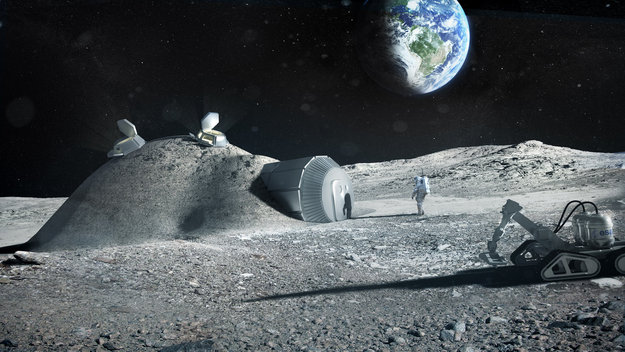There’s already been plenty of talk about 3D-printing entire buildings, but those ambitions may not remain strictly earthbound for too long. According to a new report from Phys.org, the European Space Agency and partners from London-based architecture firm Foster + Partners have begun to explore the feasibility of 3D printing a life-sustaining base on the lunar surface.
Of course, lunar dust on its own wouldn’t exactly make for the best building material, prompting the parties involved to look at ways to bolster the durability of their would-be moon base. Simulated moon dust was then combined with magnesium oxide and a “binding salt” to help the concoction settle properly, and the whole process is apparently capable of working in the vacuum of space thanks to a crafty approach to extruding liquids on the lunar surface.
Early concept designs from F+P feature a large weight-bearing dome along with a “cellular structured wall” to help protect inhabitants from ambient radiation and micrometeoroid strikes. There’s still a dearth of practical issues that need to be explored, but the printing process seems to work well enough on Earth.
“Our current printer builds at a rate of around 2 m per hour, while our next-generation design should attain 3.5 m per hour,” said Enrico Dini, founder of UK 3D printing company Monolite. He went on to say that the process of completing an entire building would take about a week, though whether or not that same timeframe could apply to actual lunar construction remains to be seen.
Granted, the notion of buliding a moon base out of the moon itself seems more than a little out there, but it’s really just a modern twist on an well-worn concept. Concepts like the Mars Direct plan (first conceived in the late 80s/early 90s) took a similar approach to managing fuel for long-term Mars missions. Under it, an unmanned vehicle would be sent to Mars and would use a cache of hydrogen and an onboard nuclear reactor to help create methane and oxygen for use as return fuel for a later manned mission. With weight being one of the biggest limiting factors when it comes to space travel, the ability to craft a habitable environment almost exclusively with materials found at the landing site could dramatically ease the process of establishing long-term enclaves off-world.
